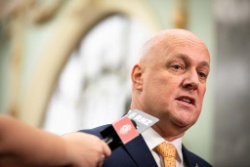Freeman & Bleifuss: A Way to Restore Confidence
A Way to Restore Confidence
By Steven F. Freeman and Joel Bleifuss
The South Florida Sun-Sentinel & Truthout.org
Monday 30 October 2006
Widespread concern over recent reports from Princeton University on Diebold machine susceptibility to tampering, and from New York University on e-voting more generally, confirm what computer scientists have long known and contended: There is little reason for confidence in election results obtained from electronic voting machines.
Yet voters in the United States are denied the one powerful technique that might restore confidence in election results - an independent exit poll.
In next week's midterm elections, 90 percent of Americans will vote on electronic touch-screen voting machines or optical-scan systems. According to a 2005 study by the Government Accountability Office, these systems have inherent flaws that "could allow unauthorized personnel to disrupt operations or modify data and programs that are critical to ... the integrity of the voting process."
Three companies - Diebold, ES&S and Sequoia - control 80 percent of the nation's voting and tabulating machines. These companies that we entrust with our franchise operate without public oversight. The software in machines of all three companies are proprietary, and when voters faced with surprising election results have sued to examine the machines, elections officials have claimed they are prohibited by contract from allowing inspection.
In response to concerns about electronic voting, Sens. Barbara Boxer, D-Calif., and Chris Dodd, D-Conn., recently introduced the Confidence in Voting Act, which according to Boxer "urges local jurisdictions to make paper ballots available at every polling place, so any voter who wants one can use one."
Such legislation would not have been enough. Given the lack of a reliable means of counting these votes, systematically auditing those counts and securing ballots in case of dispute, America must support an alternative means of checking the veracity of the official count.
A public, transparent exit poll is just such an alternative.
Around the world, exit polls - surveys of how voters immediately upon leaving the polling place say they have voted - are used to verify the integrity of elections. In nations with reliable voting systems, such as Britain and Germany, exit poll results are within 1 or 2 percentage points of the official numbers.
Discrepancies between exit polls and the official count have generally been understood to indicate corrupted counts. In four nations - Serbia, Peru, Georgia and Ukraine - they have been used to successfully overturn election results. In each case, subsequent elections, re-run with more secure voting systems, have borne out the initial poll results.
In the words of John Tefft, former deputy assistant secretary of state and current ambassador to Georgia, exit polls are "one of the few means to expose large-scale fraud." And that is why the United States funds them in emerging democracies.
Unfortunately, although exit polls were invented in the United States and are vigorously promoted for elections abroad, here they are nonfunctional as a means of election verification.
The 2004 national exit poll was conducted for a consortium of the major news groups (ABC, NBC, CBS, CNN, FOX and AP) and was designed to be used by the media in forecasting and commentary - rather than by citizens for election verification.
This was made clear by the pollsters' response to the nationwide 7 percentage point discrepancy between the exit polls and the official count in the 2004 presidential election. In their subsequent report, the Evaluation of Edison/Mitofsky, the pollsters did not include precinct-level data, which the media consortium refused to release. We only know of the discrepancy - one which represents 9 million votes - because a technical glitch prevented the pollsters from promptly uploading "corrected" results, that is, results adjusted to conform to the official count.
In 2006 and future elections, the exit pollsters have stated that they will not release "corrected" results even to their media clients. Of course, once data are "corrected," they are no longer true exit poll results; rather, they accord an unwarranted legitimacy upon the official numbers.
Unlike exit polls that we are used to seeing on election night, a transparent exit poll would not be designed to predict and analyze election results in a hurry. Instead, this poll could be designed from the ground up to check on the validity of election results.
Rigorous statistical design would separate bias in the polling from errors in the count. Such a survey could also resolve specific allegations of fraud in political jurisdictions and with voting technologies known to have a history of irregularities. The entire process - survey design, raw data and all analysis - would be open to public scrutiny.
Like the rest of the world, Americans deserve to know when voting machines have not yielded accurate counts and when an election may have been tampered with. We deserve elections that are run fairly and that inspire our confidence. Until our state and federal governments provide a voting system that we can trust, a public exit poll - open and transparent and publicly funded - would provide our best assurance of fair elections.
Steven F. Freeman is a visiting scholar
in survey methods at the University of Pennsylvania and is
co-author with Joel Bleifuss of Was the 2004 Election
Stolen?: Exit Polls, Election Fraud, and the Official
Count.


 Gordon Campbell: On The Coalition’s Awful, Not Good, Very Bad Poll Results
Gordon Campbell: On The Coalition’s Awful, Not Good, Very Bad Poll Results Ian Powell: Policy Vacuum Enables For-profit Corporate General Practice Ownership By Stealth
Ian Powell: Policy Vacuum Enables For-profit Corporate General Practice Ownership By Stealth Gordon Campbell: On Iran Killing Its Rappers, And Searching For The Invisible Dr. Reti
Gordon Campbell: On Iran Killing Its Rappers, And Searching For The Invisible Dr. Reti Peter Dunne: MPs Unusually Quiet On Pay Rise
Peter Dunne: MPs Unusually Quiet On Pay Rise Ian Powell: Cuba And New Zealand: A Relationship Worthy Of Strengthening
Ian Powell: Cuba And New Zealand: A Relationship Worthy Of Strengthening Gordon Campbell: On bird flu, AUKUS entry fees and Cindy Lee
Gordon Campbell: On bird flu, AUKUS entry fees and Cindy Lee